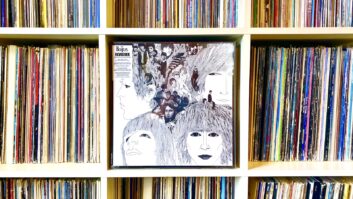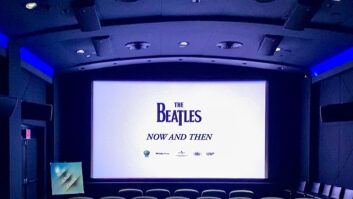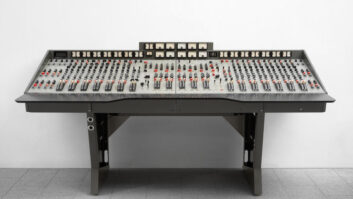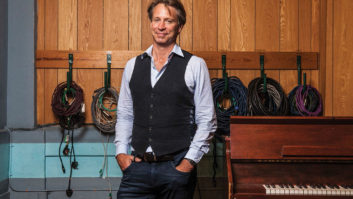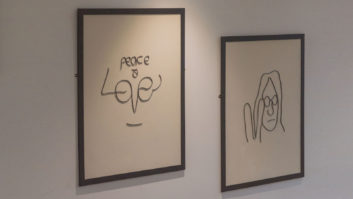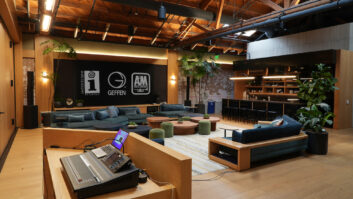Richard Langham (center) with the Beatles, circa September 1963.

The Beatles’ first album, Please Please Me, was released March 22, 1963. Today, in an age where it can take days just to get the right drum sound, it’s worth remembering that on February 11, 1963, John, Paul, George and Ringo recorded all 10 new songs for the record in a mere 10 hours.
When the Beatles walked into Studio Number 2 at Abbey Road Studios in St. John’s Wood in London, second engineer Richard Langham remembers he had to ask for introductions, because he didn’t know who the Beatles were.
“It was a very cold morning and I didn’t know any of them. I actually had to ask Norman Smith, who was the engineer, ‘Who are they? Who are who?’ so he introduced me and everything else. They were very businesslike, but they just had come down into London from the gig they had done the night before. We helped them bring all their equipment in and set it all up,” Langham told Pro Sound News at a convention in Stamford, CT back in November 2011.
During the first session, running from 10 a.m. to 1 p.m., only two songs were recorded: ‘There’s A Place’ (Lennon lead vocal) and ‘Seventeen’ (McCartney lead vocal), which was the working title for the album’s first track, ‘I Saw Her Standing There.’ The band also scheduled a second session that same day, from 2:30 p.m. to 5:30 p.m., and a third session from 7:30 p.m. to 10:45 p.m. was added later.
When asked about producer George Martin’s contributions to the band’s recordings over the years, Langham said, “I think you have to give quite a lot to George. He’d sit down with them. You’ve all seen the pictures of him on the stool with them all around, and they’d go through what they were going to do. He would then make suggestions about if he could put strings on, if he could piano on, or something like that, and this was all his work. I actually heard him use the expression, ‘If you all get killed tomorrow, I’ve got nothing to release, you have to record something.‘ That was around about ’64.”
As the second engineer at Abbey Road Studios, Langham said his main job was to make sure the artists were comfortable and that everything was taken care of.
“We set the microphones up and we also kept the logs of all the takes that were going. They were all timed, so if there was a false start or a breakdown, everything was logged, because the producers may say ‘That was okay except for the middle eight—have we got that from before?’ And then I would say, ‘I’ll tell you,’ but I would [perhaps] say, ‘That was longer, that was too long, it won’t cut in,’ so we would do another one.“
“So you kept a very accurate log of what was being recorded on that day and if anybody made a mistake, you can pull this. These days, they’ll go back and wipe everything, but we kept everything; we never wiped anything. So that was the second engineer. Also, we’d make sure there was tea there, biscuits, anything the artist wanted to keep them comfortable. That’s what I had to do for the records.”
Recalling the set-up for The Beatles in 1963, Langham said the band’s amplifiers didn’t have backs, and as the engineers would help set up, they would find pieces of paper thrown into the amps.
“Because they were rushing around the country all the time and their amplifiers maybe broke down or something like that, there were no backs on the amplifiers, you see; they were just boxes with their speakers. And as I was putting it all up, we’d look for dirt inside, but there were bits of paper lying around in there, and I picked them up. They were notes from the girls from the dance floor who threw them up on the stage—they said ‘Please play this, please play that, this is my phone number.’ I guess they just read them and then threw them in the back of the amplifier, all of these bits of paper in there! But they were fine, just like any other group that’s coming in to record,” Langham said.
At the time, Langham said they used 2-track tape, and the band tried to complete a recording as soon as possible.
“We used to do stereo and go down to mono, so we would record stereo but there would be mono feed, because that’s usually what the singles would be released as. Eventually we became twin-track so we could have the ability of dubbing afterwards. Now obviously, as you know, in those days, Dolby wasn’t around so you could only overdub to a certain extent before the tape took over. [Studio] Number 2 had up to four a track of the available tracks and we could bounce tracks onto one, reduce them all down, and so you had to be very careful, you know; you tried to get everything in on the first take.”
Langham also commented on Abbey Road engineer Norman Smith, who was the engineer for Please, Please Me. “He was ‘Ehhh.’ No, I don’t mean that at all; he was really nice. Wouldn’t take any rubbish from anybody. He knew what he was doing and was in complete control and looked after his staff as well,” Langham commented. “Norman and I used to steal Ringo’s cigarettes, I’m afraid. We didn’t have any money in those days and we’d just go down to fix his microphone, we’d know he was not there and George and I would stand there around his microphone and his cigarettes would be lying on the drum. We’d take the cigarettes out, but he never noticed, so it was fine!”
And even with Lennon suffering from a cold that day, the session resulted in ten new songs for the 14-song LP (the other four songs being the A- and B-sides of their two previously released singles), with the last recorded song being the now-legendary, throat-shredding performance by John Lennon on ‘Twist and Shout.”
